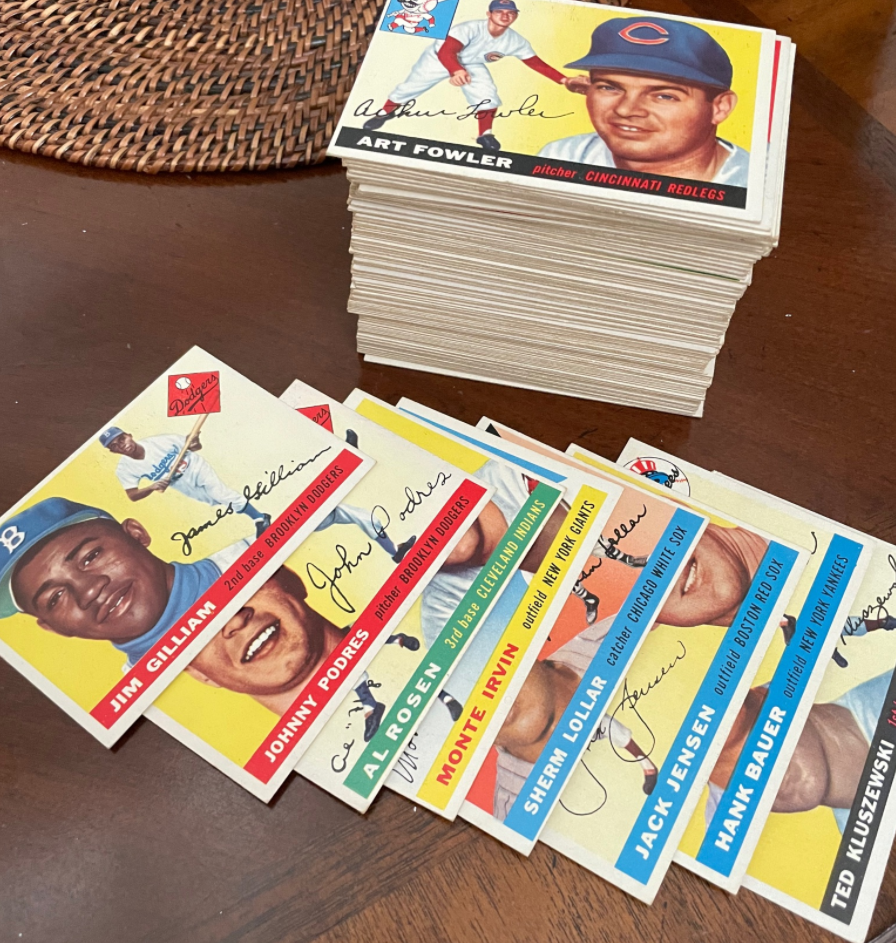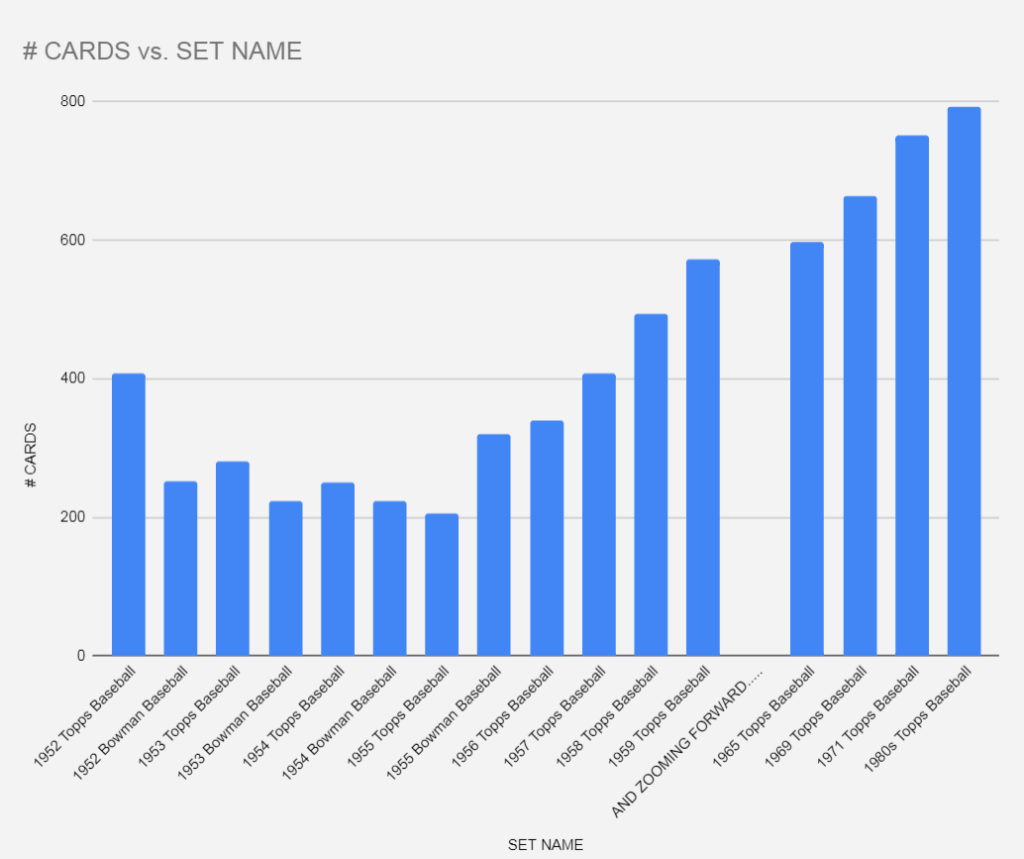People who love their collectibles chase a myriad of collectible types for a myriad of reasons. Within sports cards, there are collectors who only chase modern cards. There are others who only chase vintage cards. There are rookie card collectors, and there are “moments” collectors — but some of the most interesting collectors that you will find in the hobby are the collectors who love to build entire sets from a given year.
It is pretty well known that most modern era base sets are not that valuable after removing one or two key base rookie cards. That is not the case for the vintage card sets. It also turns out that building vintage baseball and football card sets from the 1950s is a very achievable goal for many patient collectors.
Collectors who are willing to pursue a mix of graded and non-graded cards and a mix of conditions can assemble a complete set from the 1950s without much difficulty.
WILL IT BREAK THE BANK?
Building entire card sets from a year can range from very affordable up to the stratosphere, so having goals, ranges and a budget is imperative for collectors. It is the star cards, particularly if they are graded, that will add up the fastest. And buying some of the high-number cards issued later in that year individually can rack up fast depending on what condition the cards are in.
Collectors Dashboard wanted to share some tips and estimates as to how and why building sets is not that difficult. We also wanted to highlight why this such an interesting opportunity for collectors. We have already identified which top rookie cards may break the bank from the early 1950s and then again from the latter-half of the 1950s.
REAL LIFE SET/LOT COSTS
We wanted to offer some real life examples of how purchasing certain lots can make for great tools for building these sets from the 1950s. It is true that the 1952 (and somewhat the 1953 ) Topps sets can be expensive even in not so great of condition.
The low number of total cards in the mid-1950s allow collectors to easily build those collections and here are two real-world examples that have been seen firsthand on a personal level from a large vintage 1950s collection purchased in the past. Several set builders have been able to accumulate many cards at once, like about half (or more) of an entire set all at once.
One was a 1955 Topps lot in VG+ to EX condition, 135 cards in total sold for $460.00, including some stars in the lot. That is 65% of the set at an affordable price to allow the other star, HOF and other high-number cards to be purchased.

Another lot was for 140 cards from the 1955 Bowman baseball set (Image below by Collectors Dashboard). That lot was sold for $450.00 in the 1-224 series, which means it was all lower number cards. That is almost 44% of the entire set that is a good base to build off of for a buyer.

Another large lot was of nearly 200 cards from the 1956 Topps baseball card set. That one included some stars and team cards but was missing the key Hall of Fame and other major stars. It sold for less than $700.00.
AND WHERE ELSE TO GO…
eBay, other top auction houses, and many online storefronts can also be incredible sources for big set lots as well. Just be advised that many dealers and the sports card investors are also looking for these groups of cards so that they can get a discount buying a larger lot to sell the cards individually.
Buying on-site and in-person is another option, even during the endemic (if the pandemic never ends). There is the local card shop angle to consider, as well as attending sports collectors conventions around the country.
THE HEART & SOUL OF COLLECTING
One aspect about building sets is that it captures entire seasons in history in a way that appeals to die-hard card collectors. In some ways, the set-builders are perhaps the heart and soul of collecting. For every Hall of Famer or star card, there are 10 or 20 other common cards of players that most people in this day and age never heard of.
Having an entire vintage card set from any year can also be an incredible tool for showing younger generations of kids and new collectors just how different the sets looked back then. Some collectors are obsessed with the smaller cards of the late 1940s and early 50s. Others are obsessed with the slightly larger card formats from 1952 through 1956. And then came the biggest change a year after Topps acquired Bowman — the 1957 Topps cards went to
All of this effort in set building also puts it into perspective about just how much smaller the MLB was in teams and in geography prior to the late 1950s. This was before the expansion teams of the 1950s and 1960s was made possible to head out west (and back and forth) because of jet travel.
SMALL NUMBERS & MISSING SUPER-STARS
Assembling sets from the 1950s, particularly from 1953 to 1956, is fairly easy due to there only being 200 to 300 cards per set (seem comparison at the end). Some of these sets are also missing some top stars and some do not have rookie cards. The Bowman sets right before the last 1955 Bowman set are known for not having the expensive rookie cards that are so desirable today. And there are many missing years of the baseball greats from sets as well:
Jackie Robinson did not have Bowman cards after 1950 and he did not make the journey to Los Angeles after his 1956 Topps card was his last.
Mickey Mantle’s 1952 Topps will break the bank in almost any condition, but he does not have 1954 nor 1955 Topps cards due to him signing exclusively with Bowman. Should Mickey Mantle cost so much more than Willie Mays?
Stan Musial is missing from many 1950s sets, effectively not having Bowman cards after 1951 and not having an appearance with Topps until his All-Star card in 1958 and his first regular Topps card in 1959.
Ted Williams appears in the 1951 Bowman set, but after he was taken back for jet fighter service in the Korean War he missed the 1952 and 1953 Bowman sets (and partly missed the 1954 Bowman set, with a smaller run due to contract issues). There is not a Topps Ted Williams from 1952 and 1953, and then Topps took the ends by making him the first and last card of the 1954 set after his return.
Aaron, Koufax, Clemente… Hank Aaron’s rookie card of the 1954 Topps did not have a rival for the 195 Bowman set. Sandy Koufax’s 1955 Topps rookie card did not have a 1955 Bowman counterpart competing for attention. Roberto Clemente’s high-number 1955 Topps set also did not have competition from Bowman for a cheaper alternative.
Other stars are missing in some key sets as well due to military service, due to contract exclusivity, or simply for reasons unknown.
SIZE DOES MATTER
Collectors Dashboard also created a ranking of each set from the 1950s below to show just how few cards there are versus later and modern sets. Topps went into the 600-card sets by the latter half of the 1960s and the sets went above 700 cards in the 1970s before settling into a tradition of 792 cards per set in the 1980s.
The infographic below will show just how much each set grew from the mid-1950s over time.

The lowest number of cards in any of the major 1950s sets was the 1955 Topps Baseball set of just 206 cards. That was due to the rivalry and exclusive contracts that allowed Bowman to keep players out of the Topps set (and ultimately forced Topps to buy Bowman). The number of cards in a set rises handily thereafter. The sets went over 600 in the 1960s, then over 700 in the 1970s before settling in at 792 for at least a decade in the 1980s.
*************
Anyhow, this was just a small primer on strategies for assembling the 1950s baseball card sets. The same can be applied to football card sets of the era.
There is a chance that this all just adds up to much effort. For those who have to get instant gratification, all of the sources above are known for selling complete sets from the 1950s (and the 60s, 70s and modern era) already fully complete or perhaps just missing a couple or few key cards.


